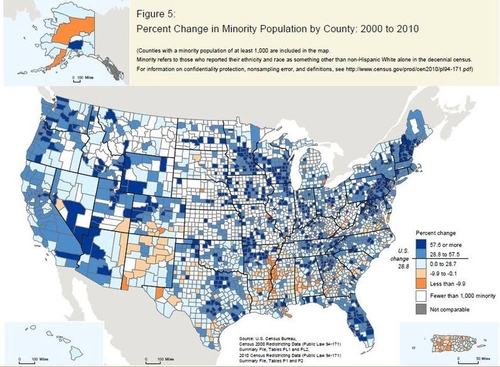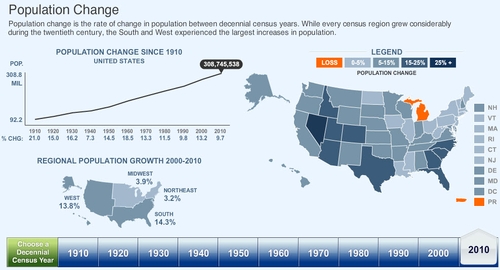
Hispanics now account for more than half of the U.S. population increase over the last decade, exceeding estimates in most states. Also, pulled by migration to the Sun Belt, America's population center edged westward on a historic path to leave the Midwest.
The Census Bureau released today its first set of national-level findings from the 2010 count on race and migration, detailing a decade in which rapid minority growth, aging whites and increased suburbanization were the predominant story lines.
Racial and ethnic minorities are expected to make up an unprecedented 90 percent of the total U.S. growth since 2000, due to immigration and higher birth rates for Latinos. Currently the fastest growing groups, Hispanics are on track to exceed 50 million, or roughly 1 in 6 Americans; among U.S. children, Hispanics are now roughly 1 in 4.
Census takers do not differentiate between respondents based on immigration status.
Based on a Pew Hispanic Center analysis, the 2010 count of Hispanics was on track to be 900,000 higher than expected as their ranks surpassed census estimates in roughly 40 states. Many of their biggest jumps were in the South, including Alabama, Louisiana, North Carolina and Louisiana, where immigrants made large inroads over the last decade.

Geographers estimate that the nation's population center will move southwest about 30 miles and be placed in or near the village of Plato in Texas County, Mo.
'Transformational decade'
Asians for the first time had a larger numeric gain than African-Americans, who remained the second largest minority group at roughly 37 million. Based on the 2010 census results released by state so far, multiracial Americans were on track to increase by more than 25 percent, to about roughly 8.7 million.
The number of non-Hispanic whites, whose median age is now 41, edged up slightly to 197 million. Declining birth rates meant their share of the total U.S. population dropped over the last decade from 69 percent to roughly 64 percent.
"This really is a transformational decade for the nation," said William H. Frey, a demographer at Brookings Institution who has analyzed most of the 2010 data. "The 2010 census shows vividly how these new minorities are both leading growth in the nation's most dynamic regions and stemming decline in others."
"They will form the bulk of our labor-force growth in the next decade as they continue to disperse into larger parts of the country," he said.
The population changes will result in a shift of 12 House seats and electoral votes affecting 18 states beginning in the 2012 elections.
Among other findings:
- In at least 10 states, the share of children who are minorities has already passed 50 percent, up from five states in 2000. They include Mississippi, Georgia, Maryland, Florida, Arizona, Nevada, Texas, California, New Mexico and Hawaii.
- Over the last decade, Latino population growth was most rapid in the South, where many states have seen their Latino populations double since 2000. For the first time, Hispanic population growth outpaced that of blacks and whites in the region, changing the South's traditional "black-white" image.
- More than half of the cities with the largest African-American concentrations showed black population declines in the last decade.
Source: MSNBC.com, “New milestone: 1 in 6 US residents is Hispanic,” March 24, 2011, and http://2010.census.gov/.